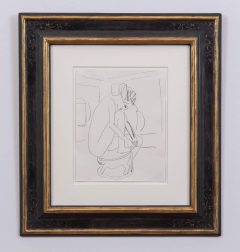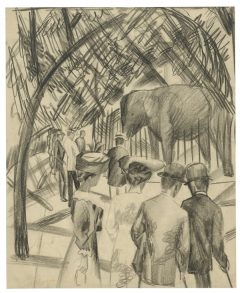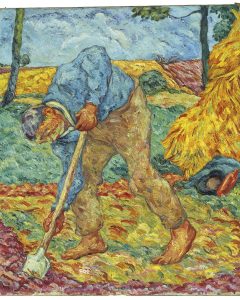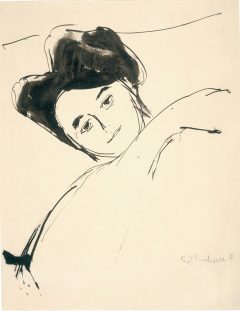Ernst Ludwig Kirchner
Akt auf Hocker (Kamerun) - Kauernde Dodo
ca. 1910

pencil on paper
34.5 × 27.5 cm / 13 9/16 × 10 13/16 in
verso with the Basel estate stamp vs and "B Dre/Bg 64" and "K 2730" numbered
The work has been registered by the Ernst Ludwig Kirchner Archiv Wichtrach/Bern
Estate of the artist; Galerie Nierendorf, Berlin (1966); Private Collection Vienna
- Galerie Ludorff, "Muse & Modell", Dusseldorf 2014
- Galerie Ludorff, "Meisterwerke des Expressionismus", Dusseldorf 2011/2012
- Museum der Weltkulturen Frankfurt, "Ernst Ludwig Kirchner und die Kunst Kameruns", Frankfurt 2008
- Galerie Ludorff, "Drawn World: Zeichnungen von Menzel bis Warhol", Düsseldorf 2019, S. 70
- Galerie Ludorff, "Muse & Modell", Dusseldorf 2014, p. 10
In 1905, Ernst Ludwig Kirchner founded the ‘Brücke’ artists' association in Dresden together with Erich Heckel, Karl Schmidt-Rottluff and Fritz Bleyl. The budding artists prefer to spend their free time painting together in nature. They went on excursions to the surrounding area, often to the Moritzburg lakes to swim and enjoy the sunshine. Kirchner always has his sketchbook to hand so that he can quickly capture situations and experiences with his pencil. He focussed on the totality of figure, space and movement in order to depict them as vividly as possible. The quick note of what he perceived remained significant for Kirchner in all phases of his work: I learnt to appreciate the first sketch, so that the first sketches and drawings were of great value to me. How I often laboured to consciously complete on canvas what I had thrown down without effort in a trance on the sketch. 1)
Kirchner's drawings are the actual centre of his oeuvre, from which both painting and printmaking are derived. Our nude drawing dates from around 1910, when the artist developed his expressive drawing style. This resulted from his discovery of African and Oceanic art in the Dresden Ethnological Museum. The young artist was also interested in Indian and East Asian art. These works made me almost helpless with rapture. I thought I would never be able to achieve this unprecedented uniqueness of representation with monumental calmness of form; all my attempts seemed hollow and restless to me. I copied a lot of the pictures in order to gain my own style. 2)
The cowering nude is his friend ‘Dodo’ - Doris Grosse - his favourite model of the Dresden years. The encounter with Dodo was extremely formative for Kirchner. Seven years after the separation, he still remembers his lover in a diary note dated 5 July 1919: Your fine fresh love lust, with you I experienced it completely, almost to the danger of my destiny. But you gave me the strength to speak about your beauty in the purest image of a woman. 3) The female figure is drawn with a strong, unbroken black line and is strictly outlined. A tense dynamism and energy, but also a lightness and light-heartedness of expression emanate from the drawing, which betrays the outstanding expressionist. The dissolved, flowing line captures the essentials as the basic element of the design, omitting the details. However, Dodo's nudity does not appear flirtatious or provocative, nor does she adopt a pose that is characteristic of nude models. Kirchner often takes up the motif of the squatting woman, also in his wooden sculptures. The wood-carved leopard stool from Cameroon is a gift from Erich Heckel's brother Manfred, who had worked as an engineer in German East Africa. The spatial ambience is more precisely defined; it is Kirchner's home studio, which he furnished with self-designed decorations and carved sculptures modelled on primitive art, as the collector Gustav Schiefler recalls: He had rented a strange studio in a suburban street in Dresden, out of necessity: a narrow grocer's shop that opened onto the street with a large window and next to which a small room served as a bedroom. These rooms were fantastically furnished. 4) The furnishings here are for everyday use and not for adornment with the unfamiliar. Kirchner wanted to overcome the alienation from art and not just see it as isolated aesthetic objects. Instead of fleeing from civilisation, Kirchner creates a free space in which he can achieve his great goal - the harmonious combination of life and art.
1) Ernst Ludwig Kirchner, ‘Die Arbeit E. L. Kirchners’, c. 1925/26, in: Eberhard W. Kornfeld, ‘Ernst Ludwig Kirchner. Nachzeichnungen seines Lebens", Bern 1979, recited in: Magdalena M. Moeller/Roland Scotti (eds.), ‘Ernst Ludwig Kirchner - Gemälde, Aquarelle, Zeichnungen und Druckgrafik - Eine Ausstellung zum 60. Todestag’, exhib. cat., Munich 1998, p. 12.
2) Cited ibid. p. 101.
3) Nationalgalerie Berlin, ‘Ernst Ludwig Kirchner’, exhib. cat., Berlin 1980, p. 121.
4) Magdalena M. Moeller (ed.), ‘Von Dresden nach Davos - Ernst Ludwig Kirchner Zeichnungen’, exhib. cat., Munich 2004, p. 72.








